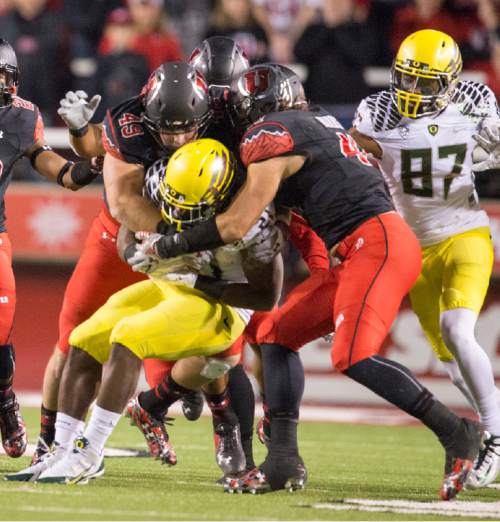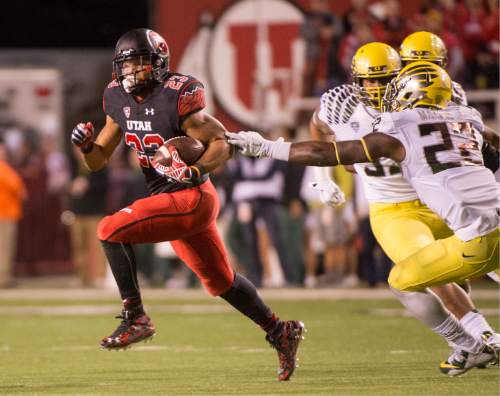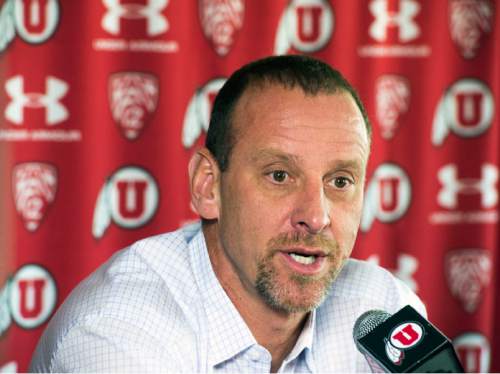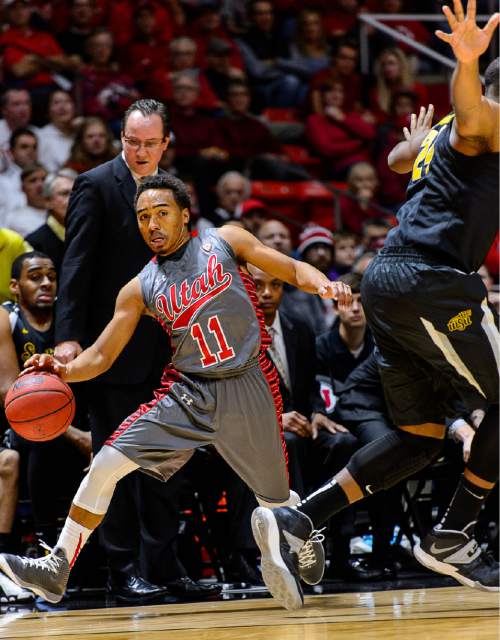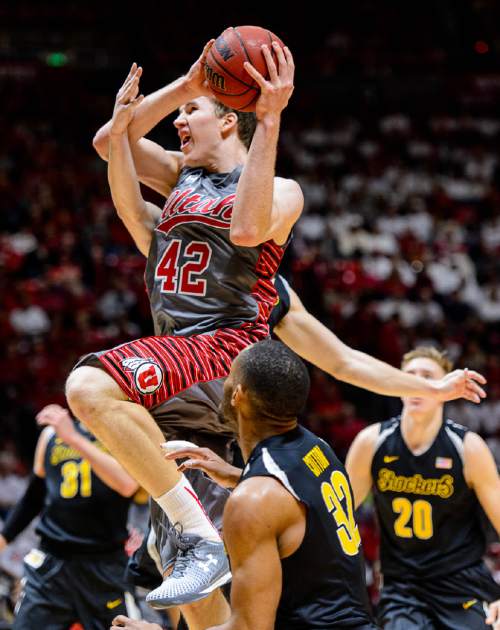This is an archived article that was published on sltrib.com in 2015, and information in the article may be outdated. It is provided only for personal research purposes and may not be reprinted.
It's 1996, and Kelly Sharitt is the equipment manager at the University of Alabama-Birmingham when a radio host begs a favor.
"This guy has this shirt that you wear under your shoulder pads," he says. "Would you mind if he comes by and sees you?"
Sure, Sharitt tells him, that'd be fine.
In pulls the radio host's buddy, a recent special teams captain at Maryland, who opens the trunk of his car to reveal white, short-sleeved compression T-shirts.
It's all he has — there are no other colors or styles.
But Sharitt is impressed by the clingy, moisture-wicking fabric. He agrees to buy them.
And that's it.
Really. That's the whole story.
The radio host, incidentally, is Ian Fitzsimmons, formerly of 1320 KFAN.
The T-shirt salesman is Under Armour founder Kevin Plank.
And Sharitt, today in his eighth year of Utah's director of football equipment, is one of the first customers of one of the world's biggest clothing companies.
—
An "Under Armour school" • Utah's athletic teams have long made sport-by-sport outfitter deals — when they made deals at all. The football team changed from Nike to Under Armour in 2008, while the men's basketball team swapped Nike for Adidas in 2007. Others had no contracts.
"It was kind of a mess," said Utah athletic director Chris Hill.
After its invitation to the Pac-12, Utah decided to accept bids for a department-wide provider. Under Armour, it found, offered the sweetest, though Nike's was "close," Hill said. So, in July 2011, Utah became the lone so-called "Under Armour school" in a Nike-dominated conference, representing the burgeoning clothing and footwear giant in its competitor's deepest regional imprint. Saturday, the No. 18 Ute football team will face No. 13 Oregon in Eugene, the alma mater of Nike co-founder Phil Knight and the epicenter of Nike's global influence.
The 2016 football season is Utah's last under the Under Armour contract, through which Utah's teams receive $2.4 million per year — $1.8 million in product allowance, at retail value, and $600,000 in cash.
Under Armour receives, well, quite a bit.
The company likely recoups most or all of that investment through the licensing fee it charges a third-party retailer to sell branded gear to Ute fans, said Jonathan Jensen, a sports marketing consultant and assistant professor at Merrimack College.
The exposure it gets on live television is gravy.
The Portland Business Journal's Matthew Kish curates a sortable database of publicly available outfitter contracts that reveals Utah's deal to be the sixth-most lucrative among public Under Armour schools and fifth among 10 public schools in the Pac-12.
Under Armour and Adidas have had to pay more, Jensen said, to knock Nike off its perches — with Adidas most recently awarding Arizona State an annual $4.2 million through 2023.
Yes, Under Armour has come a long way since its inventory sat in the trunk of Plank's car. Generating $3 billion in sales last year, it offers more products than ever.
But Nike is still Nike. For college programs, there's still value in the name.
—
An eye on the youth • Early on, some Utah coaches needed reassurances about the Under Armour agreement, Hill said.
It started as a football company. Would that hurt recruiting in other sports?
Larry Krystkowiak had recently been hired, and he acknowledges, "you didn't see that many [Under Armour] shoes on the court" at youth events.
Under Armour has since signed Stephen Curry, who wore its shoes as the best player on the NBA's champions. Notre Dame, an Under Armour school, nearly beat Kentucky to advance to last year's Final Four. Krystkowiak has been told the company plans to spend "a lot of money" in the coming years on grassroots basketball. And the non-apparel product has improved, he said.
"They were on a learning curve with shoes, but it's a great shoe [now]. I've seen amazing growth."
Still, Jensen said, Nike has between a 90 to 92 percent market share in basketball shoe sales. Under Armour may simply never hold the cachet in the hoops community that Nike does.
Football coaches have less to worry about. In his world, Kyle Whittingham said, Under Armour has long been a "hot brand."
Utah provides its players "as much gear as probably just about anybody in the country," Whittingham said. Krystkowiak echoes that: "They take great care of us." And Sharitt said football players also get a kick out of testing new Under Armour products during spring camp.
While most U. teams own at least three jerseys, Whittingham's bunch has four: interchangeable red, white and blacks, plus throwbacks that they'll wear for the Oct. 10 homecoming game against Cal.
Between the jerseys and four helmet variations, the Utes can wear a unique combination in all 13 games.
If that sounds a little like Oregon, which makes national news with its weekly uniform unveilings, that's no accident.
"Oregon's the bell cow for what we're trying to do," Sharitt said. "Not that we're trying to emulate them, but they've definitely set the tone."
Utah exceeded its allowance (it pays at a retail rate until it hits $1.8 million, and then a wholesale rate after that) to buy the throwbacks, so Under Armour isn't doing it out of the goodness of its heart. But the school has been pleased with Under Armour's responsiveness.
Under Armour creative director Adam Clement said the alternate gray jerseys the Runnin' Utes wore against Wichita State were ordered up by Krystkowiak — "one of those guys that has really taken to the idea of variety and how that can have a direct correlation on recruiting" — and his team was happy to oblige.
They haven't won over everybody. Senior running back Devontae Booker is among the Utah players who grew up "a Nike guy," and he still wears his Jordans to events like the Pac-12 Media Days in Burbank Calif.
"I just deal with what I've got to deal with right now," he said, bluntly.
But even Booker will concede that as he's worked camps over the summer, he's noticed that a growing number of the youngsters have ditched the Swoosh for the interlocking UA.
—
What's next? • The Under Armour gear sold in stores is made by a third-party company, Gear For Sports, that reproduces Under Armour's designs using the same fabrics, patterns and weights and sells the goods to retailers.
And it's a godsend, said Utah licensing director Brett Eden. In the past, working directly with Nike, Utah would sometimes simply not receive a product when it failed to meet minimums.
"In a retail scenario, that's death," Eden said. "All of a sudden, you're caught with this big demand and no supply."
Eden, like Sharitt — who moved to Utah from Louisiana Monroe because "I felt like I helped start [Under Armour], and I wanted to be a part of it" — provides a positive account of working with the outfitter.
It was Under Armour's fault when retailers received the Utah's new football jerseys before the team did last August, Hill said, but the problem was "rectified," and he's heard no such complaints recently.
Of 73 people who responded to a Tribune query question about which company they'd choose to outfit Utah Athletics, 34 picked Under Armour, 30 chose Nike, five said they couldn't care less, and only one preferred Adidas.
Many of those favoring Under Armour liked the thematic parallels between a company and an athletic program that have hit their stride together, and that Under Armour gives Utah its full attention while Nike is widely thought to have treated Utah as an afterthought.
Wrote Blake Rodee, "Under Armour seems to consider Utah a valuable customer. It didn't appear that Nike had the same opinion."
Those who preferred Nike were more likely to use the word "better" in their explanation. Wrote U. student Shams Islam: "Better material, looks better, works better."
Utah's contract bars it from soliciting offers from competitors until March 2017. For 90 days after that, Under Armour can match any offer and renew the affiliation.
That's "pretty restrictive," Jensen said, as these deals go. "... You don't see many rights of first refusal."
He believes it would be smart to drum up interest from Adidas, to leverage Under Armour and Nike.
As to whether Nike would ever pay Utah the same attention that Under Armour has, Hill said, "that was a long time ago with Nike, and that was in a different league, with different visibility. ... It would be different. They'd be responsive to us."
—
It bears noting that not every student-athlete is overly concerned about the markings on his or her gear.
Utah corner and off-brand consumer Cory Butler-Byrd said he'd happily play in a T-shirt.
Wideout Kenneth Scott said that growing up, "You could find me in Ross, trying to get the Reeboks on sale."
And Stevie Tu'ikolovatu never owned any Nike or Under Armour. The big defensive tackle from East High was grateful for whatever his mom could afford, he said.
The only gear he requires is a jersey that's loose enough for him to breathe in.
"After you put the helmet on, it's just another day. ... All you see is your opponent."
Where Utah's deal ranks
Utah gets $2.4M from Under Armour per year — $1.8M in product allowance and $600K in cash. Here's where the Utes rank among other Pac-12 schools for which the information is public record:
• 1. UCLA, $7.5M ($4M allowance, $3.5M cash), Adidas; 2. Washington, $3.5M ($2.7M/$700K), Nike; 3. Oregon, $3M ($2.2M/$600K), Nike; 4. Arizona St., $4.2M (breakdown unknown), Adidas; 5. Utah; 6. Washington St., $2.2M ($2M/$200K), Nike; 7. Oregon St., $2.2M (all allowance), Nike; 8. Arizona, $2.2M (all allowance), Nike; 9. Cal, $2.2M ($2M/$150K), Nike; 10. Colorado, $2.1M ($1.6M, $400K, Nike.
Under Armour schools ahead of Utah • 1. Cincinnati, $4.9M total, $1M cash; 2. Maryland, $4.4M total, $1.6M cash; 3. Auburn, $4.4M total, $1.9M cash; 4. South Carolina, $3.4M total, $1.2M cash; 5. Texas Tech, $2.4M, $750,000 cash.
Source: The Portland Business Journal —
What does Under Armour have in store for the Utes?
Next year's Utah football and men's basketball uniforms have already been designed.
But that's about all Under Armour creative director Adam Clement is allowed to say about them.
"We have a few tricks up our sleeve," Clement said. Asked to elaborate, he said after a thoughtful pause: "We're always looking for opportunities to tell stories about Utah."
In the past, that's meant mountain basketball shorts and football sleeves — a polarizing design among Utah fans but one that came at the request of the school. His creative team wanted to know what set Utah apart from other schools, he said, and the U. chose to highlight the mountains.
Clement said it was a particular treat to design the throwback jersey that Utah will wear for its homecoming game against Cal on Oct. 10.
"Utah football has a tradition that dates back, but throughout the course of time, they're one of the teams that really have changed uniforms a lot," he said.
The interlocking U.'s on the sleeve are from the '60s, the number styling is from the '70s, the black outline on the numbers is from the '80s and the stripe on the sleeves and pants is the "Utah stripe," a popular industry term along with the "Northwestern stripe" and "UCLA stripe."
Clement enjoys working with Utah, he said. Red, white and black is a popular, well-balanced color palette — red a color of power, black a color of intimidation — that make a "bold, aggressive statement."
And Utah empowers his creative team, he said.
"We have some partners that just want to be the same. They don't want to change, that's their tradition. Then, we have other schools that really want to have the ability to be different, like Utah."


